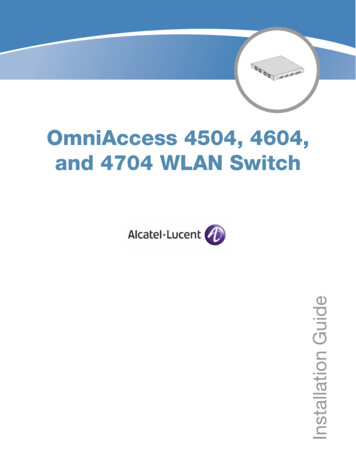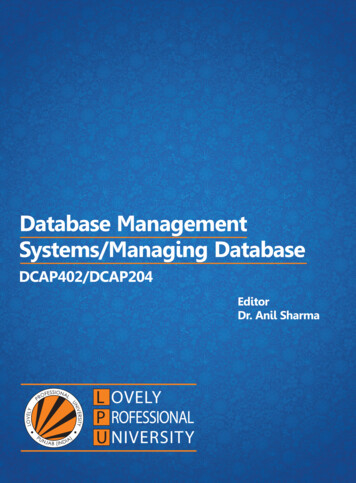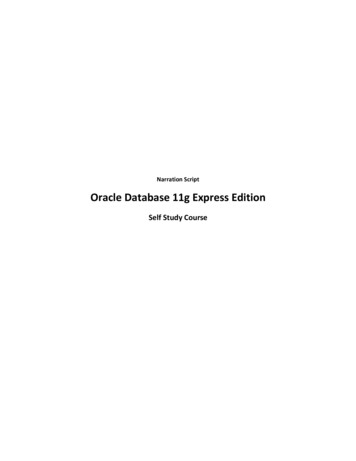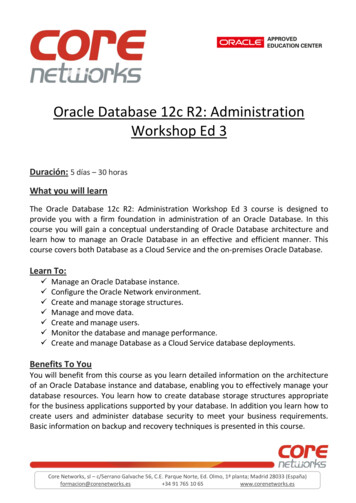
Transcription
CS 4604: Introduction toDatabase Management SystemsFunctional DependenciesVirginia Tech CS 4604 Sprint 2021Instructor: Yinlin Chen
Today’s Topics Functional dependencies (FD)–––––DefinitionArmstrong’s “axioms”FD closure and coverAttribute closure(Super)key and candidate key
Steps in Database Design Requirements Analysis– user needs; what must database do? Conceptual Design– high level description (often done w/ER model)– ORM encourages you to program hereCompleted Logical Design– translate ER into DBMS data model– ORMs often require you to help here too Schema Refinement– consistency, normalizationToday Physical Design - indexes, disk layout Security Design - who accesses what, and howCompleted
Bad Relation Converted from E/R Diagram Hard to use (CRUD)Mental effort (Treat others are mind readers)Arbitrarily (No rules followed)Redundancy (Space, Inconsistencies, etc.)
Relational Schema e987-65-4321908-555-2121San Jose One person may have multiple phones, but lives in only one city Primary key is what? What is the problem with this schema?
Relational Schema e987-65-4321908-555-2121San JoseAnomalies: Redundancy repeat data Update anomalies what if Fred moves to “Oakland”? Deletion anomalies what if Joe deletes his phone number?
Relational Schema DesignBreak the relation into 87-65-4321908-555-2121San 21San JoseAnomalies have gone: No more repeated data Easy to move Fred to “Oakland” Easy to delete all Joe’s phone -6789510-555-6543987-65-4321908-555-2121
Relational Schema Design (or Logical Design) How do we do this systematically?– Start with some relational schema– Find out its functional dependencies (FDs)– Use FDs to normalize the relational schema
Functional Dependencies (FDs) X Y: ‘X’ functionally determines ‘Y’ Informally: ‘if you know ‘X’, there is only one ‘Y’ to match’ If t is a tuple in a relation R and A is an attribute of R, thent[A] is the value of attribute A in tuple wyer
Functional Dependencies (FDs)Formally: X Y (t1[X] t2[X] t1[Y] t2[Y])if two tuples agree on the ‘X’ attribute, they *must* agree on the ‘Y’attribute, too (eg., if ids are the same, so should be 234Lawyer
Functional Dependencies (FDs)X and Y can be sets of attributesA FD on a relation R is a statement:– If two tuples in R agree on attributes A1, A2, , An then they mustalso agree on the attribute B1, B2, ., Bm– Notation: A1,A2, An B1, B2, , Bm
Functional Dependencies (FDs) A FD is a constraint on a single relationalschema– It must hold on every instance of the relation– You can not deduce an FD from a relation instance!– But you can deduce if an FD does NOT hold using aninstance
FD ExampleAn FD holds, or does not hold on an ry1234LawyerEmpID à Name, Phone, PositionPosition à Phonebut not Phone à Position1234 à1234 àClerkLawyer
FD Example - 2XYXYXY1613131713132813132323343414X YX YX Y
FD Summary FD holds or does not hold on an instance If we can be sure that every instance of R will beone in which a given FD is true, then we say thatR satisfies the FD If we say that R satisfies an FD, we are stating aconstraint on R
Why We Need 87-65-4321908-555-2121San JoseAnomalies: Redundancy repeat data Update anomalies what if Fred moves to “Oakland”? Deletion anomalies what if Joe deletes his phone number?
An Interesting Observation Workers(ssn, name, lot, did, since) If these FDs are true:– ssn à did– did à lot Then this FD also holds:– ssn à lot
An Interesting Observation - 2 If all these FDs are true:– name à color– category à department– color, category à price Then this FD also holds:– name, category à priceIf we find out from application domain that a relation satisfies some FDs,it doesn’t mean that we found all the FDs that it satisfies!There could be more FDs implied by the ones we have.
Finding New FDs: Armstrong’s Axioms (AA) Suppose X, Y, Z are sets of attributes, then:– Reflexivity: If X Y, then X Y– Augmentation: If X Y, then XZ YZ for any Z– Transitivity: If X Y and Y Z, then X Z Sound and complete inference rules for FDs! Some additional rules (that follow from AA):– Union: If X Y and X Z, then X YZ– Decomposition: If X YZ, then X Y and X Z– Pseudo-transitivity: If X à Y and YW à Z, then XW àZ
Armstrong’s AxiomsProve ‘Union’ from three axioms:
Armstrong’s AxiomsProve Decomposition:XàY, So does X àZ
Armstrong’s AxiomsProve Pseudo-transitivity:XW àYWAugmentationXW àZTransitivity
Example Relation R: { A, B, C } F { A à B and B à FDs––––––Aà CAC à BCAB à ACAB à CBAC à B C}
Closure of a set of FDs Given a set F of FDs, the set of all FDs is calledthe closure of F, denoted as F Use Armstrong’s Axioms to find F Trivial FD: using reflexivity to generate all trivialdependencies Non-trivial FD:– Using transitivity and augmentation
Examples of Computing Closures of FDs Let us include only completely non-trivial FDs in theseexamples, with a single attribute on the right F {A B, B C}– {F} {A B, B C, A C, AC B, AB C} F {AB C, BC A, AC B}– {F} {AB C, BC A, AC B} F {A B, B C, C D}– {F} {A B, B C, C D, A C, A D, B D, }
FDs - ‘canonical cover’ FcGiven a set F of FD (on a schema)Fc is a minimal set of equivalent FDs. Eg.,takes(ssn, c-id, grade, name, address)ssn, c-id - gradessn- name, addressFssn,name- name, addressssn, c-id- grade, name
FDs - ‘canonical cover’ FcFcssn, c-id - gradessn- name, addressssn,name- name, addressssn, c-id- grade, nameF
FDs - ‘canonical cover’ Fcwhy do we need it?– easier to compute candidate keysdefine it properlycompute it efficiently
FDs - ‘minimal cover’ Fcdefine it properly - three properties– 1) the RHS of every FD is a single attribute– 2) the closure of Fc is identical to the closure of F(ie., Fc and F are equivalent)– 3) Fc is minimal (ie., if we eliminate any attributefrom the LHS or RHS of a FD, property #2 isviolated
FDs - ‘minimal cover’ Fc#3: we need to eliminate ‘extraneous’attributes. An attribute is ‘extraneous if– the closure is the same, before and after itselimination– or if F-before implies F-after and vice-versa
FDs - ‘minimal cover’ Fcssn, c-id - gradessn- name, addressssn,name- name, addressssn, c-id- grade, nameF
FDs - ‘minimal cover’ FcAlgorithm:examine each FD; drop extraneous LHS or RHSattributes; or redundant FDsmake sure that FDs have a single attribute intheir RHSrepeat until no change
FDs - ‘minimal cover’ FcTrace algo forAB- C (1)A- BC (2)B- C (3)A- B (4)
FDs - ‘minimal cover’ FcTrace algo forAB- C (1)A- BC (2)B- C (3)A- B (4)split (2):AB- CA- BA- CB- CA- B(1)(2’)(2’’)(3)(4)
FDs - ‘minimal cover’ FcAB- CA- BA- CB- CA- B(1)(2’)(2’’)(3)(4)AB- C (1)A- CB- CA- B(2’’)(3)(4)
FDs - ‘minimal cover’ FcAB- C (1)AB- C (1)A- CB- CA- BB- CA- B(2’’)(3)(4)(2’’): redundant (implied by (4), (3)and transitivity(3)(4)
FDs - ‘minimal cover’ FcAB- C (1)B- C(1’)B- CA- BB- CA- B(3)(4)(3)(4)in (1), ‘A’ is extraneous:(1),(3),(4) imply(1’),(3),(4), and vice versa
FDs - ‘minimal cover’ FcB- C(1’)B- CA- B(3)(4)B- CA- B(3)(4) nothing is extraneous all RHS are single attributes final and original set of FDsare equivalent (same closure)
FDs - ‘minimal cover’ FcBEFOREAB- CA- BCB- CA- B(1)(2)(3)(4)AFTERB- CA- B(3)(4)
Attributes Closure If we just want to check whether a givendependency X à Y is in the closure of a set Fof FDs– We can just compute the attribute closure X withoutcomputing F Compute attribute closure X with respect to F– X is the set of attributes A such that X àA is in F
Closure of AttributesGiven (INPUT) :– Attributes {A1, A2, . An}– Set of FDs SFind (OUTPUT) :– X {A1, A2, , An}
Closure Algorithm
Closure of a set of Attributes
Example Relation R: { A, B, C, D, E } F { B à CD, D à E, B à A, E à C, ADà B} Is B à E in F ?––––evaluate the closure of BB à CD, D à EB {B, C, D, E, .}Thus B à E
Definition of Keys FDs allow us to formally define keys A set of attributes {A1, A2, ., An} is a key forrelation R if:– Uniqueness: {A1, A2, ., An} functionally determineall the other attributes of R– Minimality: no proper set of {A1, A2, ., An}functionally determines all other attributes of R
Definition of Keys A superkey is a set of attributes that has the uniquenessproperty but is not necessarily minimal– A1, ., An à B A candidate key(or sometimes just key) is a minimalsuperkey If a relation has multiple keys, specify one to be primarykey If a key has only one attribute A, say A rather than {A}
Computing (Super) Keys For all sets X, compute X If X [all attributes], then X is a superkey Try reducing to the minimal X’s to get thecandidate key
Example Product(name, price, category, color) FDs– name, category à– category à colorprice Candidate key:– (name, category) { name, category, price, color }– Hence (name, category) is a candidate key
Closures of Attributes vs Closure of FDsBoth algorithms take as input a relation R and a set ofFDs FClosure of FDs:– Computes {F} , the set of all FDs that follow from F– Output is a set of FDs– Output may contain an exponential number of FDsClosure of attributes:– In addition, takes a set {A1, A2 , An} of attributes as input– Computes {A1, A2, , An} , the set of all attributes B, such thatA1 A2 An B follows from F– Output is set of all attributes– Output may contain at most the number of attributes in R
Example Relation R: { A, B, C, D, E } F { B à CD, D à E, B à Is D a superkey?– evaluate the closure of D– B à CD, D à E– D {D, E, C} Is AD a superkey?– evaluate the closure of AD– AD à B,– AD {A, D, E, C, B} Is AD a candidate key? Is ADE a candidate key?A, E àC, AD àB}
Example 2 Relation R: { C, S, J, D, P, Q, V } F { JP à C, SD à P, C à CSJDPQV } Is SDJ is a key?– JP à C, C à CSJDPQV, so JP is a key– SD à P, so SDJ à JP– So SDJ à CSJDPQV Is SD à CSDPQV ?
Reading and Next Class Functional Dependencies: Ch 19.1-19.3 Next: BCNF, 3NF and Normalization: Ch 19.419.9
Database Management Systems Virginia Tech CS 4604 Sprint 2021 Instructor: Yinlin Chen Functional Dependencies . Today’s Topics Functional dependencies (FD) –Definition –Armstrong’s “axioms” –FD closure and cover –Attribute closure –(Super)key and candidate key. Steps i










